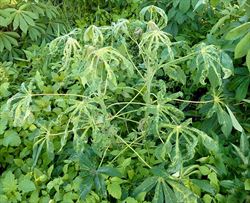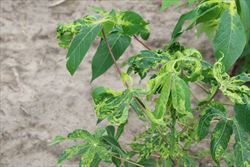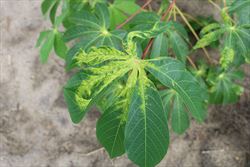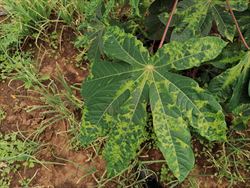Cassava mosaic virus diseases.
Pacific Pests, Pathogens, Weeds & Pesticides - Online edition
Pacific Pests, Pathogens, Weeds & Pesticides
Cassava mosaic diseases (520)
There are several virus strains causing cassava mosaic virus diseases, and their names tell from where they were found. Initially three strains (African cassava mosaic virus, East African cassava mosaic virus, Indian (and Sri Lanka) cassava mosaic virus) were isolated and, later, strains within these groups were identified as sequencing methods developed. Presently, more than 10 strains are recognised, with more likely.
Originally, the virus was named cassava latent virus; this was because the geminiviruses (twinned particles with circular strands of DNA) that were later found to cause the mosaic were so difficult to detect in diseased plants, either under the electron microscope or in sap-inoculation tests to the virus-indicator plant, Nicotiana clevelandii. Once the exact nature of the virus was known, strains were identified based on their geography and serology, and nowadays by molecular assays. The viruses have been classified as members of the Geminiviridae family, and they are spread by whiteflies. The abbreviation of African cassava mosaic virus is ACMV.
Asia, Africa (widespread, including Madagascar and Seychelles). ACMV is NOT present in Pacific island countries, nor are any of the related strains. It is thought that ACMV is native to East Africa as variation there is greatest; from there it spread elsewhere in Africa and to Asia. In Asia: African, ACMV; Indian, ICMV; and Sri Lankan, SLCMV. In 2018, the Sri Lankan strain was detected in Thailand and Vietnam near the border with Cambodia.
As cassava is an introduced plant, it is possible that the virus was originally in non-cassava plants and made the jump to cassava when whiteflies were introduced.
Cassava. A number of non-cassava hosts have been found across Africa, and there are others that have been infected experimentally. In Pakistan, non-cultivated cotton species have been found to be hosts. Other wild hosts are found in the Fabaceae and Euphorbiaceae families, such as Centrosema pubescens, Leucaena leucocephala, Manihot glaziovii, Pueraria phaseoloides, and Senna occidentalis.
Leaves show pale green to yellow patches, giving what is called a 'mosaic' pattern; often, the large yellow areas cover extensive areas of the leaves. Deformed and distorted leaves and shoots are common and plants are stunted. There is great variation between leaves, between shoots and between plants of the same variety. This variation may be due to different strains, the present of complexes of strains, tolerances of the host or differences in environmental conditions, such as soil moisture and temperature. Some plants do not show symptoms although the virus is present. In general, the greater the leaf symptoms, the greater the loss in storage root yields. However, most roots do not show internal symptoms, such as the rots that occur with cassava brown streak disease (see Fact Sheet no. 439), but may show rotting caused by soil organisms if plants become severely weakened by ACMV.
It is important to note two fact about the epidemiology of the mosaic disease: (i) infections usually occurs in the first 3 months after planting, after that time plants are little affected; (ii) plants can show leaf symptoms, but not all cuttings taken from those plants will produce virus-infected plants; this is because the virus is not fully systemic in cassava. (This is similar to Cucumber mosaic virus in kava - see Fact Sheet no. 160).
Spread occurs in stem cuttings used as planting material locally and over long distance exchanges between farmers. Once planted, the first and subsequent leaves from infected cuttings show the characteristic mosaic symptoms and distortions. Spread occurs from the feeding of whiteflies (Bemesia tobaci). Although individual whiteflies do not move far from where they first fed (about a 20 m radius), they can be dispersed over several kilometres by wind, infesting crops rapidly. Whiteflies take about 3 hours to acquire the virus from infected plants, they are able to transmit it after 8 hours and once infectious take about 10 minutes of feeding to pass it on. They remain infective for about 7-9 days. Symptoms develop from about 1 month after infection.
A very important disease with enormous impact on cassava production in East Africa. Food security is dependent on storage roots of cassava, particularly in times of drought and famine, and the leaves are used as an important vegetable.
From 1988 onwards, massive losses occurred in East and Central Africa during devasting outbreaks of East African cassava mosaic virus-Uganda where farmer-preferred varieties were highly susceptible to the new strain, and food supplies were affected. The pandemic that resulted caused many farmers to abandone the crop and famine-related deaths occurred.
CABI quotes losses from a range of varieties of 15-24% in Africa, equivalent to 12-23 million tonnes a year, valued at US$1.2-2.3 billion, in the 1990s.
In large parts of Africa, cassava is grown in areas that are in close proximity, allowing new strains to arise and spread by whiteflies and/or the sharing of planting material. Under these conditions, hybridisation of virus strains occurs as seen with the development of East African cassava mosaic virus-Uganda, a combination between African cassava mosaic virus and East African cassava mosaic virus.
Look for leaves with mosaic symptoms, leaves and shoots that are distorted and deformed and plants that are stunted. A number of different ELISA tests are available for detection of the virus, as well as PCR tests.
BIOSECURITY
Countries still free from the cassava mosaic disease should take all practical measures to prevent its introduction and further spread. Once introduced, the virus is very difficult to eradicate because cassava cultivation is continuous, alternative hosts are likely present, as are whiteflies. Whenever cassava varieties are moved officially between countries they should be as pathogen-tested plantlets growing in sterile media according to the FAO/IBPGR Technical Guidelines for the Safe Movement of Cassava Germplasm - https://www.google.com.au/webhp?sourceid=chrome-instant&ion=1&espv=2&ie=UTF-8#q=international%20guidelines%20for%20cassava. The disease presents a considerable concern to South America, many parts of Asia and Pacific island countries. In 2015, the Sri Lankan strain was introduced to Cambodia and spread quickly. In 2018, a regional control plan was devised by Cambodia, Laos, Thailand and Vietnam, with the assistance of CIAT and IITA.
BIOCONTROL
No program has been initiated, but two potential biocontrols have been considered: the fungi Isaria (formally Paecilomyces) farinosa and Isaria fumosorosea. Natural predators include lacewing larvae (see Fact Sheet no. 270), big-eyed bugs (Geocoris spp.) (see Fact Sheet no. 370), ladybird beetles (see Fact Sheet no. 83), the larvae of syrphid (hoverflies) flies (see Fact Sheet no. 84), and predatory mites. They all attack immature stages of whiteflies.
CULTURAL CONTROL
In general, where conditions are favourable for intensive cassava cultivation for most of the year (usually where annual rainfall is over 1500 mm) and varieties are susceptible, sanitation alone is not a method of control; this is because whiteflies and sources of infection are too abundant. Under these conditions, control is best attempted by combining cultural controls with resistant varieties.
Before planting:
- If practical, select cutting from a disease-free source. For subsistence growers, this means carefully noting plants that remained disease-free in the previous crop and planting cuttings taken only from them.
- Do not establish new plots next to those that are infected with the mosaic disease, especially if the young plots are downwind.
- Plant a mixture of varieties together, both susceptible and resistant.
- Do not plant cassava near alternative hosts, for instance, castor oil. Similarly, do not plant near crops that are ready hosts of whiteflies, such as sweet potato or tomato.
- Establish government-managed schemes to produce healthy planting material of popular varieties, with encouragement to farmers to rid themselves of infected susceptible varieties. Such schemes are being re-assessed in Uganda.
During growth:
- Encourage farmers to rogue infected plants. Roguing should be done as soon as symptoms are seen. If done early, adjacent plants will compensate for the yield loss from the plants removed. It is important to remember that disease is worse when cuttings are the source of infection, compared to whiteflies as the source.
After harvest:
- Collect and destroy stems of those plants that showed symptoms of cassava mosaic symptms. DO NOT use them as a source of planting material.
RESISTANT VARIETIES
Resistant cultivars are widely available, and they have different responses to infection. Some may be difficult to infect (although, if infected, symptoms are severe), in others symptoms are restricted to a late stage of growth and may become symptomless. A useful characteristic of the latter is that not all cuttings are infected; consequently, they can be grown repeatedly where susceptible varieties are severely diseased. IITA (International Institute of Tropical Agriculture) is the lead research organisation assisting breeding programs in Africa.
CHEMICAL CONTROL
Broad-spectrum insecticides such as pyrethroids (e.g., deltamethrin, lambda cyhalothrin, bifenthrin), neonicotinoids (e.g., imidacloprid) and organophosphates (e.g., chlorpyriphos) should be avoided, as repeated use promotes the development of resistant whiteflies, and they will also destroy natural enemies. Resistance to insecticides is a serious problem in the control of Bemisia tobaci, which has become resistant to a wide range of insecticides. Transgenic varieties are also being produced to cassava mosaic disease.
If insecticides are required, do the following:
- Use horticultural oil (made from petroleum), white oil (made from vegetable oils), or soap solution (see Fact Sheet no. 56). The sprays will not kill all of the whiteflies, but will allow predators and parasites to increase and bring the whitefly infestation under control. Frequent applications (every 3-5 days) and good coverage is required.
- Several soap or oil sprays will be needed to bring the whiteflies under control. It is essential that the underside of leaves and terminal buds are sprayed thoroughly since these are the areas where the whiteflies congregate. It is best to spray between 4 and 6 pm to minimise the chance of leaves becoming sunburnt.
- White oil:
- 3 tablespoons (1/3 cup) cooking oil in 4 litres water.
- ½ teaspoon detergent soap.
- Shake well and use.
- Soap:
-
Use soap (pure soap, not detergent).
- 5 tablespoons of soap in 4 litres water, OR
- 2 tablespoons of dish washing liquid in 4 litres water.
-
- White oil:
- Commercial horticultural oil can also be used. Note, these sprays work by blocking the breathing holes of insects causing suffocation and death. They are less likely to kill natural enemies as they are quickly broken down in the environment, and also the development of resistance to them is less likely than is the case when using synthetic pesticides.
-
Alternatively, use plant-derived products, chilli (see Fact Sheet no. 504), neem (see Fact Sheet no. 402) or derris (see Fact Sheet no. 56).
____________________
When using a pesticide (or biopesticide), always wear protective clothing and follow the instructions on the product label, such as dosage, timing of application, and pre-harvest interval. Recommendations will vary with the crop and system of cultivation. Expert advice on the most appropriate pesticide to use should always be sought from local agricultural authorities.
AUTHOR Grahame Jackson
Information from Uke A, et al. Cassava mosaic disease and its management in Southeast Asia. Plant Mol Biol (2021). (https://doi.org/10.1007/s11103-021-01168-2); and CABI (2021) African cassava mosaic (African cassava mosaic). Crop Protection Compendium. (https://www.cabi.org/cpc/datasheet/2747); and Boa E, et al. (2015) Cassava mosaic disease. In: Crop pests and diseases: A manual on the most important pests and diseases of the major foood crops grown by smaller farmers bn Africa. Africa Soil Health Consortium. CABI International, Wallingford, UK. (http://africasoilhealth.cabi.org/wpcms/wp-content/uploads/2015/09/519-ASHC-manual-English.pdf); and Zhang P, et al. (2005) Resistance to cassava mosaic disease in transgenic cassava expressing antisense RNAs targeteing virus replication genes. Journal of Pant Biotechnology 3(5):385-97). (doi: 10.1111/j.1467-7652.2005.00132.x); and from Daniel ZJ (2019) Engineering disease-resistant cassava. Cold Spring Harbor perspectives in biology 11(11). (https://cshperspectives.cshlp.org/content/11/11/a034595).
Photo 1 Phil Taylor (CABI). (https://www.cabi.org/cpc/datasheet/2535); Photos 2&3 H. Holmes Cassava mosaic disease (CMD) symptoms in a field in Tanzania. (https://www.flickr.com/photos/129099219@N03/32638164343/in/photolist-RJ88ar-TAZ1CH-nfsGJs-88VdGX-RJ88o2-cqiaZ9-81L8yB-Tpxydv-2dPfti-adke4r-SjpWxC-TpxxFZ-UbgMz3-TAZ1jr-dWUT2E-SjpWqo-fuhYHs-dWUK3j-TAYZG4-T1ZHcC-Tpxy1g-TpxxP4-fuigZA-fu49Gp-fu16Ug-SjpVUo-fu47wi-Txmsw9-c15D8s-dWPbfc-dWPcz2-fuhvz3-fuhD7G-fuivAL-dWUFNq-fu3g3V-fu1Te8-fu2kjP-fugGrf-fu2aZ2-ftZXiF-fu19Kt-fuhFNu-dWPffp-fuhPiq-fuhJLh-fu3vXD-fufErA-ftZVLD-fu1fA6), and (https://www.flickr.com/photos/129099219@N03/32638165073/in/photolist-RJ88o2-cqiaZ9-81L8yB-Tpxydv-2dPfti-adke4r-SjpWxC-TpxxFZ-UbgMz3-TAZ1jr-dWUT2E-SjpWqo-fuhYHs-dWUK3j-TAYZG4-T1ZHcC-Tpxy1g-TpxxP4-fuigZA-fu49Gp-fu16Ug-SjpVUo-fu47wi-Txmsw9-c15D8s-dWPbfc-dWPcz2-fuhvz3-fuhD7G-fuivAL-dWUFNq-fu3g3V-fu1Te8-fu2kjP-fugGrf-fu2aZ2-ftZXiF-fu19Kt-fuhFNu-dWPffp-fuhPiq-fuhJLh-fu3vXD-fufErA-ftZVLD-fu1fA6-dWP8fK-fuhW2G-fuhLV1-fu13MX). Photo 4 Stephan Winter, DSMZ-German Collection of Microorganisms and Cell Cultures Braunschweig, Germany.
Produced with support from the Australian Centre for International Agricultural Research under project HORT/2016/185: Responding to emerging pest and disease threats to horticulture in the Pacific islands, implemented by the University of Queensland, in association with the Pacific Community.







